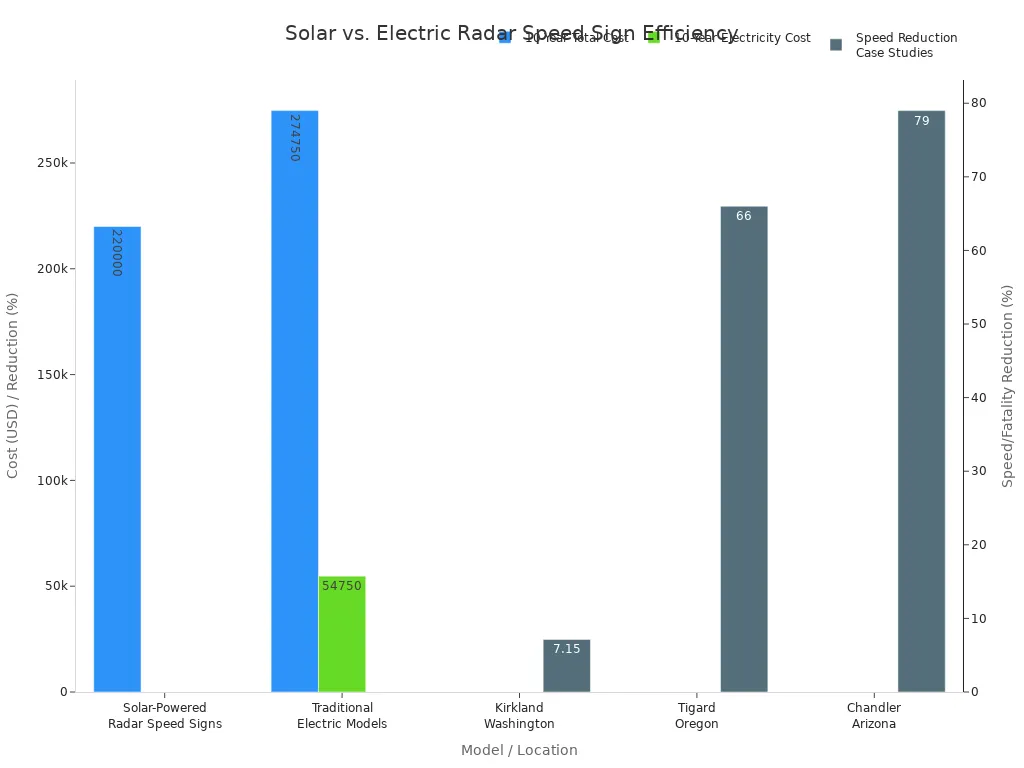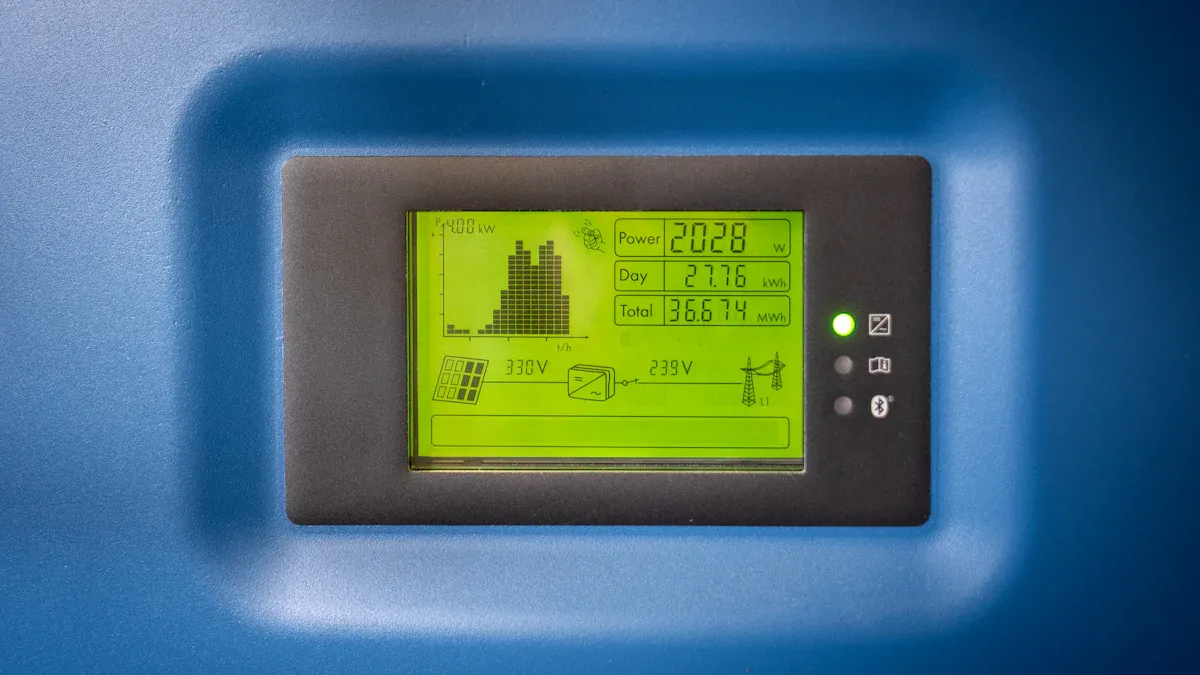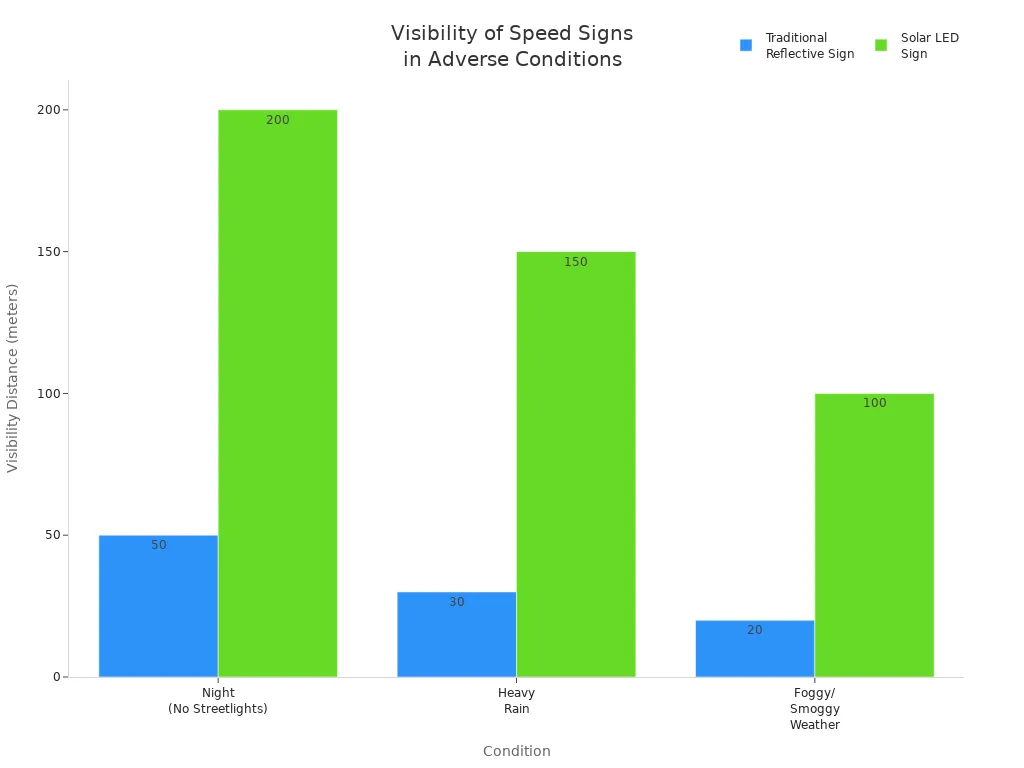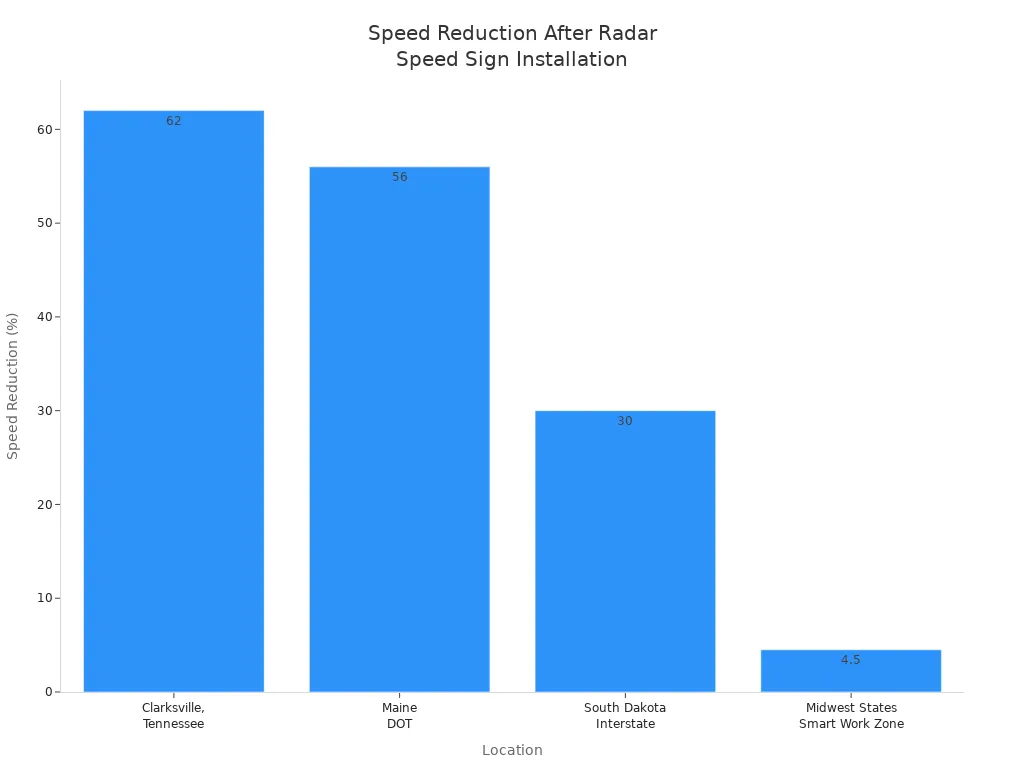- All
- Product Name
- Product Keyword
- Product Model
- Product Summary
- Product Description
- Multi Field Search
Views: 0 Author: Site Editor Publish Time: 2025-08-13 Origin: Site









You can make roads safer by using solar power solutions for speed limit signs. Solar-powered speed limit signs harness sunlight to operate efficiently and remain reliable. These signs require less wiring and electrical work, making them easier and faster to install. Solar radar speed signs function well in many locations, even where connecting to the power grid is difficult. By using solar power solutions, you gain energy independence and save money over time. The table below compares the cost and efficiency of solar radar speed signs with traditional models.
Category | Solar-Powered Radar Speed Signs | Traditional Electric Models |
|---|---|---|
Initial Investment Cost | Higher initial cost but offset by savings | Lower initial cost |
Installation Cost | Lower due to no wiring needed | Higher due to wiring and power setup |
10-Year Electricity Cost | $0 (eliminated) | $54,750 |
10-Year Maintenance Cost | Lower due to durable components | Higher maintenance expenses |
10-Year Total Cost | Approximately $220,000 | Approximately $274,750 |
Investment Return Rate | 288.43% | N/A |

solar power solutions for radar speed signs
Solar-powered radar speed signs use sunlight to work. This makes them easy to set up. They are reliable even in places without power lines.
These signs help save money over time. They lower electricity costs. They also need less fixing than regular electric signs.
Using solar power helps the environment. It lowers pollution. It supports clean energy goals.
Strong batteries and weatherproof designs help the signs work well. They keep working in all kinds of weather. This includes cloudy, rainy, or snowy days.
Good placement, regular cleaning, and battery care help the signs work their best. This helps keep roads safer.
Solar-powered speed limit signs help you use less outside energy. They get power from the sun, so you do not need to plug them into the grid. This makes them great for places far from cities or where power lines do not reach.
do not need outside power
do not need digging or lots of wires
work on their own
Wireless solar traffic control systems let you talk to and control the signs right away, so they work well anywhere.
spend less on fixing them
Regular speed limit signs always need electricity, which costs more to run and fix. Solar radar speed signs do not have these costs, so they are a smart and cheap choice for traffic control. Over time, you save money and do not have to worry about big bills.
Tip: Solar-powered speed limit signs help you save money on setup. You do not need to pay experts or buy lots of wires.
up to 80%
When you use solar radar speed signs, you help the earth and make green choices. These signs lower pollution and help your town reach its clean energy goals. Solar-powered speed limit signs also fit with city plans that want clean energy and better traffic.
use the sun’s energy
They work without the grid, so they always run, even in tough places.
help drivers be safer and collect traffic data
Their low price and online controls help keep them working for a long time.
Solar-powered speed limit signs work well in all kinds of weather. New solar radar speed signs use strong solar panels and good batteries to store power. Even when it is cloudy, backup batteries keep the signs on for up to 120 hours. This means the signs always work and help keep roads safe.
Feature | Description |
|---|---|
Battery Type | 12V/65AH lead-acid battery |
Continuous Operation | Up to 120 hours in rainy or overcast weather |
Solar Panel Power | 80W |
Purpose | Stores solar energy to power the sign when sunlight is insufficient |
IP65 ratings
Good batteries help the signs work in hot or cold weather.
bifacial panels and PERC technology
Strong materials and special coatings stop rust and damage.
Energy-saving settings and auto-dimming help the signs last longer.
Solar power solutions make your speed limit signs strong and dependable for any road. You can trust your signs to work when you need them.

Solar panels20W or 50Waluminum that does not rust
Solar panels give clean energy.
They use sunlight to make power for the sign.
The design helps LED lights use less energy.
Solar panels help lower costs for fixing and running the sign.
7 to 15 dayslithium-ion batteries
Feature | Description |
|---|---|
Battery Technology | Lithium-ion or sealed lead-acid |
Charge Retention | 7–15 days based on energy use |
Rechargeability | Solar or AC power |
Backup Role | Keeps sign working during cloudy days or outages |
Weather Adaptation | Works in low sunlight and tough weather |
Charge controllerscutting off power when the battery is low
Note: A charge controller is important for safe and smart energy use. It stops batteries from getting too full or too empty, which can hurt them.
Solar panels, batteries, and charge controllers work together with radar technology for best results. The solar power system gives steady energy to the radar sensor and display. The radar can spot cars up to 400 feet away because it uses energy well. Solar panels and batteries help the sign work in any weather. The system uses LED lights that save energy and show clear numbers. You can trust solar power to keep your radar speed sign working, easy to see, and helpful for traffic safety.
Choose a spot that gets sunlight all day
Pick a place with lots of sunlight and no shade.
Make sure the signpost is strong and face the panels south.
Connect the wires tightly to the power system.
Clean the solar panels every week
Use LED screens that do not glare so drivers can see well.
Putting your sign in the right spot helps it make enough energy. It also keeps the sign easy for drivers to see.
Check battery levels every month
Use solar panels and parts that save energy.
Pick batteries made for cold weather.
Charge batteries with solar power for best results.
Weather can change how much energy your solar panels make. Rain, snow, or dust can block sunlight and lower power. Clean your solar panels often to help them work better. Use strong and waterproof parts for your solar radar speed signs. This keeps the power system safe from rain and wind. Put your solar panels in open places to get more sunlight, even on cloudy days.
Tip: Clean your solar panels every week and look for damage after storms. This helps your solar power system work well.
Use strong, waterproof, and tough materials
Check and clean solar panels every week
Look at wires and batteries every month.
Move signs to new spots to keep drivers alert.
Use backup power for extra safety.
Good care helps your solar radar speed signs last longer and work well in any weather.
Solar radar speed signs are used in many places. You can see them on busy streets and near schools. These signs use solar energy to light up displays and run radar sensors. They help drivers see speed limits and slow down. The signs show real-time speeds, so drivers pay more attention. In crowded areas, these signs stay bright at night and in bad weather. The table below shows how well solar LED signs work compared to regular signs in different weather:
Condition | Traditional Reflective Sign Visibility | Solar LED Sign Visibility |
|---|---|---|
Night (No Streetlights) | Visible up to 50 meters | Visible up to 200 meters |
Heavy Rain | Blurry within 30 meters | Clear up to 150 meters |
Foggy/Smoggy Weather | Barely visible within 20 meters | Clear up to 100 meters |

Tests show radar speed signs make most speeders slow down. Solar-powered speed limit signs work in all weather and need less fixing, so they give better results.
solar-powered speed limit signs
The table below gives more facts about speed drops and safety:
Location | Speed Reduction (%) | Additional Safety Data |
|---|---|---|
Clarksville, Tennessee | 62 | Safer neighborhood traffic conditions |
Maine Department of Transportation | 56 | Better speed limit compliance |
South Dakota Interstate | 20-40 | Mean speed drop of 4-5 mph, improved highway safety |
Midwest States Smart Work Zone | 2-7 | Mean speed drop of 3-4 mph, safer work zones |

sign’s angle or height
Tip: Always check the solar panel and battery wires first when fixing solar-powered speed limit signs. Clean the panels and reset the sign if you need to.
Rain, fog, snow, and ice can affect radar readings
Place speed limit signs where drivers often speed
Make sure the sign is on the right side of the road and at least 7 feet above the ground.
Choose a spot with a clear line of sight for both the radar and solar panels.
Pick the type of sign you need: stationary, portable, or ultra-mobile.
Decide if you want solar, electric, or dual power. Most people choose solar for energy independence.
A good site assessment helps your solar-powered speed limit signs work well and last longer.
Choosing the right vendor for solar-powered speed limit signs is important. Look for vendors who offer strong solar panels and reliable energy storage. Make sure the signs have bright LED displays that drivers can see from far away. Ask about mounting options, like pole or wall mounts, to fit your location.
Check if the signs collect traffic data and offer easy ways to download reports.
Make sure the signs meet MUTCD standards for safety and compliance.
Look for weatherproof and vandal-resistant designs.
Ask about warranties and customer support.
Choose vendors who offer flexible power options, such as solar, battery, or AC.
A good vendor will help you with installation and provide support if you need repairs.
flashing strobe lights
Choose from different power options: solar, AC, or battery.
Add Bluetooth or cloud access for remote data downloads.
Select mounting kits for poles or flat surfaces.
Use software to collect and analyze traffic data, like average speed and vehicle counts.
Add extra locking plates if you want to move the signs between locations.
Customization lets you use solar-powered speed limit signs in school zones, neighborhoods, or work areas. You can make your speed limit signs work best for your community.
use energy from the sun, so they cost less and need less fixingcars slow down and streets get safer, especially near schools
Try a pilot program in important spots
Make clear goals and gather data.
Team up with local groups to get money and help.
Picking renewable solutions like these signs keeps your town safe and good for the environment.
Most batteries last 5 to 7 years. You can help them last longer by checking them often and keeping the solar panels clean. Good care means your sign works well every day.
Yes, these signs work in cloudy or rainy weather. The batteries store extra energy from sunny days. You get up to 120 hours of power, even when the sun does not shine.
You do not need to do much. Clean the solar panels once a week. Check the wires and batteries every month. This keeps your sign bright and working well.
Place your sign where it gets sunlight all day. Avoid shade from trees or buildings. Put it where drivers can see it from far away. This helps drivers slow down and stay safe.
Yes, you can move them. Many signs use portable mounts. You can place them in school zones, work areas, or busy streets. This gives you flexibility for changing traffic needs.
Navigating the vast, diverse highways and streets of the United States can feel overwhelming, whether you are a new driver, a commercial fleet manager, or an overseas contractor preparing for traffic projects in the US.
On roads worldwide, arrow road signs are essential in shaping driver behavior, reducing congestion, and ensuring safety. From simple turn instructions to complex temporary lane changes during construction, these signs provide clear visual guidance to drivers and pedestrians alike.
Every driver has encountered traffic signs, but few consider why they are shaped and colored in specific ways. The shape of a traffic sign is not an aesthetic choice; it is a deliberate design for instant, universal recognition, ensuring safety and efficiency on roads across the globe.
Traffic lights are the lifeblood of modern road systems, directing the dance of vehicles and pedestrians while ensuring safety, efficiency, and smooth traffic flow. Explore the key differences between 1/4-Way LED and Single Way traffic lights.
Navigating the vast roads of the United States requires understanding the traffic lights rules that govern intersections, pedestrian crossings, and traffic flow control systems nationwide.
Solar energy has rapidly emerged as a game-changing resource in various industries, especially in lighting systems. By harnessing the power of the sun, solar-powered lighting offers a sustainable alternative to traditional energy sources, reducing dependence on fossil fuels and lowering carbon emissions.
Urban areas around the world are rapidly expanding, with an increasing focus on sustainable development to meet the needs of growing populations. In this context, sustainable infrastructure plays a crucial role in ensuring that cities remain livable, energy-efficient, and environmentally friendly.
When selecting a lighting tower for construction or outdoor projects, cost plays a crucial role in the decision-making process. Choosing the right lighting solution can have a significant impact on the overall project budget, including both initial investment and long-term operational costs.
Solar hybrid lighting towers are a cutting-edge solution that combine renewable solar energy with traditional power sources to provide reliable lighting in a wide range of environments. These towers are designed to harness the power of the sun through solar panels, which charge a battery system that powers the lighting units. In cases where sunlight is insufficient, such as during cloudy weather or nighttime, these towers are equipped with a backup generator or grid power to ensure continuous illumination.
Construction sites are dynamic and fast-paced environments where safety and efficiency are paramount. One of the key requirements for ensuring smooth operations is reliable lighting, especially during nighttime or in poorly lit areas. Proper illumination not only enhances visibility for workers but also minimizes the risk of accidents and improves overall productivity.